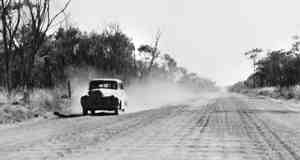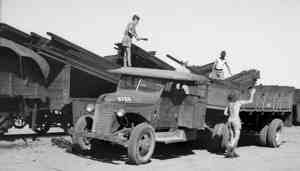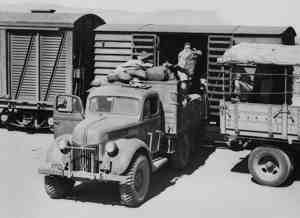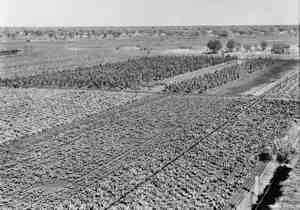
Like to copy this image? Please click here first
AWM 150145 Northern Territory, July 1942. A car moves along the Alice Springs-Darwin Road soon after the completion of the unsealed section. Note the width of the highway intended to carry military transport to and from northern war zones.
Before WW2, the ‘road’ south from Darwin was an unsealed track that became a quagmire in the wet and a dust bowl in the dry. With the escalation of the Japanese threat to Northern Australia and surrounding sea lanes the authorities realised a road linking Darwin with the south had to be constructed to supply the top end in the event of a prolonged attack by the Japanese.

Like to copy this image? Please click here first
AWM 150141 Northern Territory, July 1942. The construction of the Alice Springs-Darwin Road constituted an engineering feat of considerable magnitude and of great military importance. As sections of the 1000 mile all-weather road was completed, convoys moved supplies between Alice Springs and Darwin. Members of Australian 108th General Transport Company line up with their trucks on the Stuart Plain.

Like to copy this image? Please click here first
AWM 150142 Northern Territory, July 1942. Forming a new section of the Alice Springs-Darwin 1000 mile (1600 km) road. Bulldozers scoop out the earth from the hillside to fill in a depression.
Road construction gangs from the Main Roads Departments of Queensland, New South Wales, South Australia and the Commonwealth Department of the Interior were tasked to construct a road between Birdurn/Larrimah - the terminus for the North Australian Railway - and Alice Springs. The 600 miles of roadworks commenced in September 1940 and a formed road was completed in three months. However, the wet season of 1940-41 took its toll and it was realised that a bitumen all-weather road with bridges across creeks was essential.

AWM 026765 Alice Springs, 1942. Scene in one of the railway sidings at Alice Springs where military equipment is being unloaded for transport, per motor vehicles, to Darwin.
When the road was first built, convoys of some 70 assorted three-ton trucks carried troops, food, fuel, stores and equipment. By 1942 the trucks had been replaced by seven-ton semitrailers. (Well short of the 70-ton road trains that travel the Stuart Highway today - in 2002.)

AWM 027884 Members of Australian Army postal unit unloading north bound surface mail from the train into a truck for road transport to Larrimah, the railhead of the Darwin - Birdum railway.
Fresh supplies were a real treat in the north and ‘perishable’ runs were popular with the drivers as it gave them the opportunity to spend a day in Darwin. As it was impossible to supply all perishable requirements from Adelaide, Army farm units were set up along the route to produce fruit and vegetables to supplement canned food supplies.

AWM 055516 Wycliffe Well, NT. Army farms were established to try to reduce dependence on imported produce and provide fresh supplies such as pigs, poultry, fruit and vegetables. Wycliffe Well is on the main north road 235 miles (375 kms) north of Alice Springs.
Large petrol dumps had to be established near staging points as fuel usage was high due to the evaporation rate from drums exposed to sun and high temperatures, and heavy fuel consumption from head winds and high loads.
Over four years the continuous stream of well-organised convoys collectively drove about 100 million miles and moved almost 200,000 troops, their food and supplies.
The 600-mile road through the middle of Australia provided Darwin and the top end with a lifeline. How different life would have been had the rail line that is under construction in 2002 been built sixty years before.
Construction work on a 1420-km rail line between Alice Springs and Darwin started in June 2001. At a projected cost of around AU$1.3 billion, the line is expected to open in 2004.





